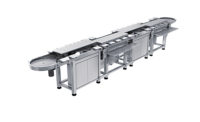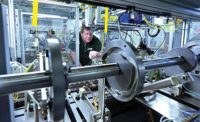There’s an old joke that the factory of the future will be so automated that it will have just two employees: a guard dog and someone to feed it. Fortunately or not, such a scenario remains the purview of science fiction. Indeed, despite advances in robotics and automation, people remain the most flexible assembly technology.
Consider the automated assembly system we profiled in the June 2013 issue of ASSEMBLY (“Rotary Indexer Assembles Hinges for Car Doors”). A linear conveyor brings three components for the hinge housing to an operator, who places the parts into a fixture on a rotary indexing dial. The rest of the assembly process—installing screws, pressing plates, inserting pins, inspecting the parts, and unloading the finished product—is done automatically.
So why not load the parts automatically, too? As it turns out, there are many reasons why the integrator or the hinge manufacturer might have opted not to automate the loading process.
For one thing, some parts simply cannot be fed reliably or cost-effectively, says Jeff Stover, sales manager for systems integrator Xigent Automation. For example, an ideal part for automated feeding will always lie on the same side when scattered randomly across a flat surface. A less-than-ideal part might come up on, say, any one of eight sides.
Other parts might be too fragile or too nice in appearance to be jostled around in a vibratory bowl, says Chad Ramsey, research and technical sales specialist at systems integrator ATC Automation. In addition, some parts might be too inconsistent for automatic feeding, or they might need to be checked or manipulated in some way prior to loading.
Indeed, engineers often discover that their parts are inconsistent when attempting to automate a process that was previously done manually. It’s easy for people to discard bad parts or perform selective assembly on the fly. Such efforts often go unnoticed. An automatic pick-and-place device can’t discriminate between good parts and bad ones. It will simply try to force a square peg into a round hole, resulting in rejects and downtime.
Similarly, manual loading may be necessary if the parts are not supplied in automation-friendly packaging, says Andrew Osterholzer, president of systems integrator Flexible Automation. For example, the parts might be supplied in a box, layered between sheets of paper. While it’s easy for a person to remove each sheet of paper, automating such a process would only add to the complexity of an assembly system.
Flexibility is another reason to integrate people with automated assembly systems. If the system will be running a family of similar products, assigning a person to load the parts is often more cost-effective than investing in sophisticated robotics and tooling.
Cost Considerations
Cost may be the most important factor to consider when deciding which processes to automate and which ones to do manually, says Osterholzer. In automated assembly systems, small components are typically fed with custom-made trays or vibratory bowls, then placed with a robot or dedicated pick-and-place unit. All totaled, feeding a single part can add tens of thousands of dollars to the cost of a system. Tack on a few thousand more if a vision system is needed to guide the robot or verify part alignment.
As a result, engineers must decide whether automating any one process—such as loading, screwdriving, dispensing or packaging—will provide a reasonable return on investment. Indeed, integrators are often asked to quote the same system with varying levels of automation.
“Customers often ask us to show them what a system will look like if everything were automated, and then work it down from there to a justification they can live with,” says Stover.
“Sometimes, the choice is not always rational,” he adds. “For an extra $50,000 or whatever, I could automate a particular process. However, if the system has to pay back in six months, and automating that extra process will pay back in 18 months, then the customer may not go for it—even though, from a quality or productivity standpoint, automating that process may be a good choice.”
Given that the price of a multistation automated assembly system can run in the six- or even seven-figure range, it may seem counterintuitive to quibble over a few thousand dollars. It’s important to note, however, that an automated assembly system may not necessarily reduce a manufacturer’s labor costs.
“Often, personnel will be responsible for several different machines or processes,” says Osterholzer. “If they’re available to load the parts, the manufacturer may not save any money by automating that process. They may be standing there one way or another.”
Similarly, if an operator is needed to produce the part—cutting a wire or tube to length, for example—then it makes sense for that person to load the part into the machine, as well, he adds.
Of course, the other cost consideration is what to pay the person tending the machine. “You can try to find a minimum-wage worker to do that,” says Stover. “But, if it’s very important that the system never stops running, you need a higher caliber person to ensure that happens. In that case, you have to be willing to pay for that.”
Synchronous vs. Asynchronous
The extent to which manual processes are used in an automated assembly line can influence the design of the overall system.
Pairing one or more operators with a rotary indexing dial or other synchronous system comes with a tradeoff. “The person will invariably be the limiting factor in terms of output, maybe not in the first hour of the day, but definitely by the third hour,” says Stover.
If there are several assembly steps that are unusually long compared with the others, an asynchronous system is the way to go. Engineers can design loops off to the side where the slower processes can be performed two at a time, three at a time, or some other multiple. The faster processes—those closer to the preferred takt time—can be placed in a more linear arrangement. Asynchronous systems are also better for high-mix production.
Manual processes are typically performed at the beginning of the line (loading parts) and at the end (final inspection, functional testing and packaging). “You rarely see an operator midstream,” Osterholzer points out.
ATC recently shipped a multistation automated assembly system that consisted of both a rotary indexing dial and a linear pallet-transfer conveyor. Three operators man the system. One operator is at the beginning of the line, loading four different parts onto a pallet. Automating that process would have been cost-prohibitive, says Ramsey.
The second operator transfers the half-finished assembly from the conveyor to the dial. The third operator unloads the dial, performs a leak test on the finished assembly, and packages the product.
“The reason there aren’t more operators on the line is because of all the checks and data we collect on the assembly process,” says Ramsey.
Deciding which steps to do manually and which processes to automate was a collaborative effort between ATC Automation and the customer. “They knew their budget and manpower requirements,” says Ramsey.







